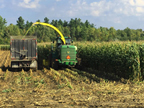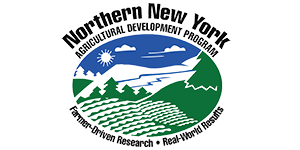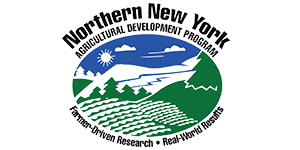
October 2, 2017. The 2017 corn harvest in Northern New York is providing data to researchers with a grant from the farmer-driven Northern New York Agricultural Development Program to compare forage quality and yield between 2 distinct types of corn.
“We are interested to see if yields for the 2017 crop will continue to show no consistent difference between the BMR and non-BMR hybrids grown for silage,” said project leader Eric O. Young, research agronomist at the William H. Miner Agricultural Research Institute, Chazy, N.Y.
“In our regional trials to date, the BMR hybrids have had a distinct advantage in fiber digestibility and, therefore, milk production potential,” Young added.
Brown MidRib, or BMR, corn has a naturally-occurring genetic variation that producers higher fiber digestibility that, in turn, increases the milk production potential of dairy cows. However, farmers are concerned that BMR corn may not yield as well as non-BMR corn hybrids.
“Until this project funded by the Northern New York Agricultural Development Program there has been relatively little research evaluating performance among brown midrib hybrids and non-BMR hybrids with respect to yield and forage quality,” Young notes.
The research in Northern NY includes two commercially-available BMR hybrids currently on the market.
Data from the 2017 harvest will be compared with trial results with 5 corn hybrids grown at 2 farm sites in 2015 and 2016.
Crop samples are evaluated for yield, digestibility, percent dry matter, acidity, starch and other components, silage fermentation and quality after harvest.
Young notes, “The differences in yield, starch, and fiber digestibility all have important implications for dairy ration formulation and farm economics. Our early results in the Northern New York trials have shown clear difference sin fiber digestibility related to corn hybrid genetics.”
This research provides a data foundation for analyzing the potential milk production impact of using BMR and non-BMR hybrids in the dairy cow total mixed ration.
The 2015 and 2016 NNY BMR evaluation reports are posted on this Northern New York Agricultural Development Program website.
The Northern New York Agricultural Development Program funds agricultural research and technical assistance in Clinton, Essex, Franklin, Jefferson, Lewis and St. Lawrence counties. Funding for the Northern New York Agricultural Development Program is supported by the New York State Senate and administered by the New York State Department of Agriculture and Markets.
BMR-Non BMR Year 2 Report, Table 7: uNDF
BMR-Non BMR Year 1 Report


 The farmer-driven Northern New York Agricultural Development Program has posted its 2018 grant announcement and application at
The farmer-driven Northern New York Agricultural Development Program has posted its 2018 grant announcement and application at 
 The farmer-driven Northern New York Agricultural Development Program provides research and technical assistance to farmers in Clinton, Essex, Franklin, Jefferson, Lewis and St. Lawrence counties. Funding for the Northern New York Agricultural Development Program is supported by the New York State Senate and administered by the New York State Department of Agriculture and Markets.
The farmer-driven Northern New York Agricultural Development Program provides research and technical assistance to farmers in Clinton, Essex, Franklin, Jefferson, Lewis and St. Lawrence counties. Funding for the Northern New York Agricultural Development Program is supported by the New York State Senate and administered by the New York State Department of Agriculture and Markets.